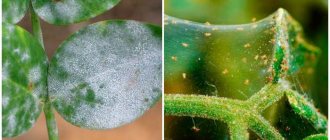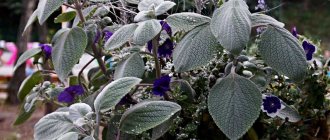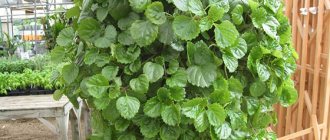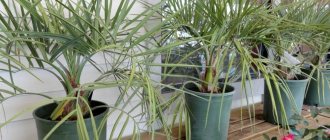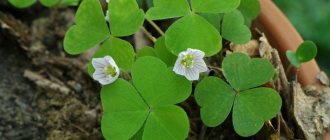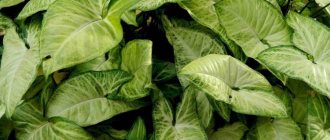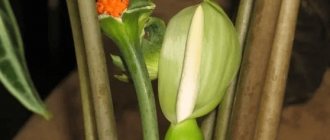Priming
For successful growth of a crop, fertile, loose, well-permeable soil is needed. The soil should have a slightly acidic pH of 6.2 to 7.2. A universal soil mixture works well.
When preparing it yourself, it is recommended to take 2 parts humus, 3 parts turf soil, 2 sand, 100 g bone meal, 20 g superphosphate.
When planting, a drainage layer (expanded clay, pieces of polystyrene) should be poured onto the bottom of the pot one-third of its height.
Possible growing difficulties
Plectranthus is highly resistant to harmful insects and diseases. But with insufficient care and keeping the plant in an unsuitable environment, it can become infected with parasites or fungal diseases, after which it can wither and even die.
Possible crop diseases and ways to eliminate them:
| Problems/illnesses | Causes | Elimination |
| Root rotting |
|
|
| Drooping state |
|
|
| The foliage has decreased in size and changed color | ||
| Powdery mildew |
| |
| Downy mildew (downy mildew) |
|
class="table-bordered">
Possible harmful insects, ways to identify and eliminate them:
| Pests | Signs of defeat | Way to get rid |
| Aphid |
| |
| Mealybug |
| |
| Spider mite |
class="table-bordered">
As can be seen from the article, homemade mint is an unpretentious plant with many advantages. And if you decide to have this flower with fragrant leaves in your apartment, then you are guaranteed a good emotional atmosphere in the house, air filled with phytoncides, as well as an aromatic food additive and a natural healer in one “bottle”.
Pot
The size of the pot depends on the amount of mint you are growing. A container with a diameter of 14 cm is suitable for one bush. Up to 5 plants can be grown in a container with a diameter of 32 cm.
Possible growing difficulties
If you do not provide the flower with optimal conditions and regular care, it will get sick and suffer from pest attacks.
Important! If harmful insects or signs of disease are detected on a flower, it is necessary to immediately isolate it from other plants and treat it.
Pests
Indoor mint can be affected by the following parasitic insects:
- Spider mite. The main sign of damage is the entwining of the stem and leaves with cobwebs. Dry air is a favorable condition for tick invasion. The fight against the parasite is carried out by wiping the leaves and trunk with a soap solution, dishwashing detergent, abundant watering and covering the bush with film for 3 days, treating with acaricides “Apollo”, “Borneo”, “Floramite”, “Flumite”.
- Aphid. Symptoms of damage are drying of the leaves, wilting of the buds, and the appearance of honeydew on the leaves and stems. The destruction of the insect is carried out by wiping with a soap solution, medical alcohol, spraying with garlic, tobacco infusion, as well as infusions of wood ash, hot pepper, and tomato tops. Among the chemicals used are “Fitoverm”, “Iskra”, “Inta-vir”, “Aktellik”, “Karate”, “Confidor”.
- Shield. This insect can be seen on the stem. It sucks nutrients from the plant, causing the flower to wither and disappear. The first symptoms of scale insects are a sticky liquid on the trunk. For control, a mechanical method is used - insects are scraped off with a brush. Folk remedies - rubbing with vinegar solution, garlic, pepper tinctures. In case of severe infection, they resort to chemical treatment using Fitoverm, Actellik, Metaphos.
- Whitefly. It is difficult not to notice the whitefly. Moths with white wings are often found above the plant. However, it is not the butterflies that pose the danger, but their larvae that feed on the leaves. As a result, they turn yellow and curl. To combat whiteflies, the above-mentioned insecticides are used. Soap solution, tobacco and dandelion infusions also help to repel insects.
Diseases
The following diseases are diagnosed in plectranthus:
- Downy mildew. It appears as gray spots on the upper leaf plate and a gray coating on the lower one. The main reason is too much watering and high humidity. To get rid of the disease, it is necessary to eliminate the causes - dry the earthen lump and air. For treatment, spray the leaves and stems with a mixture of serum (1 part) and water (3 parts); a mixture of soap (40 g), soda (50 g) and water (10 l). In case of severe damage, it is necessary to use fungicides approved for indoor plants: “Topaz”, “Skor”, “Dektra”.
- Root rot. Manifested by yellowing and falling leaves. Develops in case of excessive moisture. The plant will need to be treated with fungicides and replanted.
Important! When treating a flower with chemicals, you must adhere to personal safety rules. Carry out the treatment in a well-ventilated area, protect the eyes, nose, mouth, hands and body with special equipment.
It is prohibited to drink, drink or smoke.
In addition to diseases, the plant can also suffer due to errors in care. If it lacks something, it will signal this by changes in appearance. The most common problems encountered when growing mint are:
- Exposing the stem, shredding the foliage. Occurs due to insufficient lighting. It is necessary to move the flower to a brighter place or organize artificial lighting.
- Lightening of leaves. This is a sign of excessive lighting. It is necessary to protect the flower from sunlight.
- Falling leaves, wilting shoots. May indicate a lack of moisture. It is necessary to increase the quantity and volume of moisture.
- Root rotting, yellowing and falling leaves. May indicate over-hydration. The irrigation regime should be changed and its volume reduced.
- Lack of flowering and falling leaves. Can occur when the flower is grown in temperatures that are too cold.
So, indoor mint is a beautiful and unpretentious plant, which can be grown by a beginner in the flower business. It is placed on the windowsill, and it is used to landscape balconies, loggias, and terraces. Grown in flowerpots, pots and containers, in winter gardens.
Lighting and location
Culture loves diffused lighting. Direct sunlight is contraindicated (causes burns and discoloration of leaves). Daylight hours are at least 9 hours. This is especially necessary for variegated varieties. For illumination in winter when daylight hours are short, it is recommended to use fluorescent lamps. To avoid stretching of shoots, the plant should not be placed in a dark place.
Plectranthus should be placed on the window sills of the southwestern or eastern part of the room, where there is soft, diffused light. When located on the south side, protection from direct sunlight is necessary.
What are the benefits of indoor mint?
The benefits of mint plectranthus when used extend to many body systems. Infusions and decoctions based on spur flowers:
- relieve inflammation of the mouth and throat;
- eliminate itching and skin irritation;
- have a diuretic effect and relieve swelling;
- have sedative properties and have a beneficial effect on the nervous system;
- relieve anxiety and depression;
- have a fixing effect on diarrhea;
- promote the removal of helminths from the intestines;
- strengthen immune resistance and prevent colds;
- improve expectoration during cough and bronchitis;
- have an antibacterial effect.
We recommend reading: Rudbeckia: beneficial properties and contraindications, application
Externally, products based on indoor mint are used for irritations, allergic rashes, wounds and insect bites. Decoctions and infusions fight inflammation and help restore the skin.
Attention! Indoor mint is popular in cooking. It is added to soups and salads, liqueurs and syrups, and sweet desserts.
Trimming
Before intensive growth begins, the crown of the plant must be carefully trimmed. This will cause side shoots to grow.
Before the procedure, the pruning shears must be treated with alcohol, as the stem may be damaged (rotting will occur).
First of all, when pruning, you need to remove injured and weak branches. It is recommended to cut them to 2/3 of the length. There is no need to worry, as the cut shoots will quickly put out buds and begin to grow.
In ampelous crops, to enhance growth, you should lightly pinch the tips.
Since shrubby species grow quickly, they can be grown in the form of a ball. In this case, the lower leaves should be torn off, and the upper shoots should only be pinched.
To avoid rotting, it is best to sprinkle the cut area with charcoal powder, which has drying and antiseptic properties.
How to use homemade mint in folk medicine
The use of fragrant spur flower is practiced in home medicine. The anti-inflammatory, analgesic and strengthening properties of the plant have a positive effect on the body for many ailments.
For enuresis
The benefits and harms of decorative indoor mint allow the plant to be used for enuresis in children and adults. An infusion is prepared based on the spur flower, which is then added to healing baths. The algorithm looks like this:
- Dry or fresh plectranthus leaves are crushed in the volume of a glass.
- Pour the raw material with 500 ml of hot water.
- Leave covered for 45 minutes.
- Strain and pour the product into a filled bathing container.
It is necessary to take such a bath for half an hour shortly before bedtime. The water temperature should only be about 30 °C. Baths are taken daily or every other day until the condition improves. The procedures not only help get rid of enuresis, but also increase skin tone.
The infusion of indoor mint does not last long, so it should be prepared anew every day.
When coughing
The healing properties of aromatic plectranthus improve expectoration during colds and help relieve coughs. Traditional medicine recommends preparing the following remedy:
- About 10 g of dried leaves of the plant are poured into the teapot.
- Pour 300 ml of hot liquid into the raw material.
- Cover with a lid and leave for 15 minutes to infuse.
- Strain through a strainer and pour into cups.
You can drink medicinal tea 2-3 times a day on a full stomach.
Advice! If desired, plectranthus leaves can be mixed in equal volumes with regular tea leaves.
For psoriasis
Indoor mint copes well with skin irritations and has a beneficial effect on psoriasis, eczema and other diseases. It is recommended to use a simple infusion of an ornamental plant. They do it like this:
- Grind clean fresh leaves in the volume of half a glass.
- Brew the raw material in 1 liter of boiling water.
- Leave the infusion in a closed container for a couple of hours.
- After time, filter.
In the finished product, you need to moisten a clean cloth or gauze and treat the affected areas of the skin. It is allowed to wipe the epidermis 4-5 times a day. The infusion has a good effect on diaper rash in children and bedsores in the elderly.
For insect bites
Itching, burning and pain from insect bites are well relieved by fresh plectranthus juice. The plant is used as follows:
- Several leaf blades of the spur flower are thoroughly ground to a paste.
- Squeeze the raw material through cheesecloth to obtain pure juice.
- Soak a cotton pad in the liquid.
We recommend reading: Plakun grass (loosestrife): medicinal and magical properties, contraindications, application, photos
The juice is applied to the bite sites several times a day. The product can also be used to wipe inflamed wounds and cuts.
Transfer
Due to rapid growth, the crop must be replanted annually. The container should be 3cm larger than the root ball. In this case, it is important to inspect the root part for the absence of diseases, pests and damage.
After four years, the plant must be replanted every two years. Transplantation is best done in the spring before rapid growth begins.
Winter care
Indoor cloves - home care
All plants need a period of rest. At this time, they stock up on nutrients, accumulate strength for flowering and growing green mass.
Golden Ruffle and other varieties require a dormant period. It is organized from mid-autumn and lasts until spring. At this time, the air temperature is lowered to 15 ° C, the amount of watering is reduced, and daylight hours are reduced by an hour or two.
Plectranthus Oertendahlii has beautiful leaves with a white pattern. In order for it to be preserved, the plant is given a dormant period from October to April. At this time, the flower must receive enough light, otherwise the leaves will be green.
Growth periods (rest, flowering)
By nature, plectranthus does not need a period of rest. But you can create peace yourself. To do this, in winter you need to reduce watering and stop feeding.
Flowering usually occurs in summer. At this time, small inflorescences appear in the form of spikelets. Since flowers take a lot of energy from the crop, it is recommended to prune them.
Description of Plectranthus
The plectranthus plant is also called indoor or home mint, as well as spur flower. Basically, plectranthus is divided into erect and drooping varieties, but any species and varieties have highly branched, tetrahedral shoots. Plectranthus leaves are closely spaced, smooth or slightly pubescent, matte or glossy, in dark and light green shades.
Plectranthus grows on average up to 60-120 cm, and the leaves can reach a length of 10 cm. The photo of indoor plectranthus mint shows that the leaves of the plant are ovoid, with teeth along the edges, and are a little reminiscent of nettle leaves.
How plectranthus blooms
House mint produces recognizable corolla-shaped flowers, with one lip bent upward and the other directed downward. In the core of the flower there are 4 stamens of different lengths. The color of the flowers can be soft blue, lilac, blue or almost white - the color depends on the variety.
Plectranthus usually blooms from late spring to late summer. Homemade mint flowers are not of particular decorative value, but a fully blossomed plant looks attractive on an indoor windowsill.
Important! When growing plectranthus for medicinal purposes, the flowers are often plucked off immediately after they appear, since they take quite a lot of energy and valuable resources from the plant.
What is the scent of homemade mint?
Interestingly, the smell of plectranthus is usually only slightly reminiscent of mint. More often, gardeners note that crushed leaves smell like lungwort, camphor or chewing gum with menthol notes.
What types are common for home breeding?
Plectranthus coleus
Shrubby
Plectranthus Ertendahl
For indoor cultivation, several varieties of plectranthus are used:
- Coleus . Straight shoots, large spotted leaves. Looks like a houseplant - coleus.
- Shrubby . Named due to its impressive size (60 cm). The leaf releases essential oils with just one touch.
- Plectranthus Ertendahl . The most popular type for indoor breeding. The peculiarity is in the color of the leaves (green on top, pink on the bottom) and the smell of camphor.
